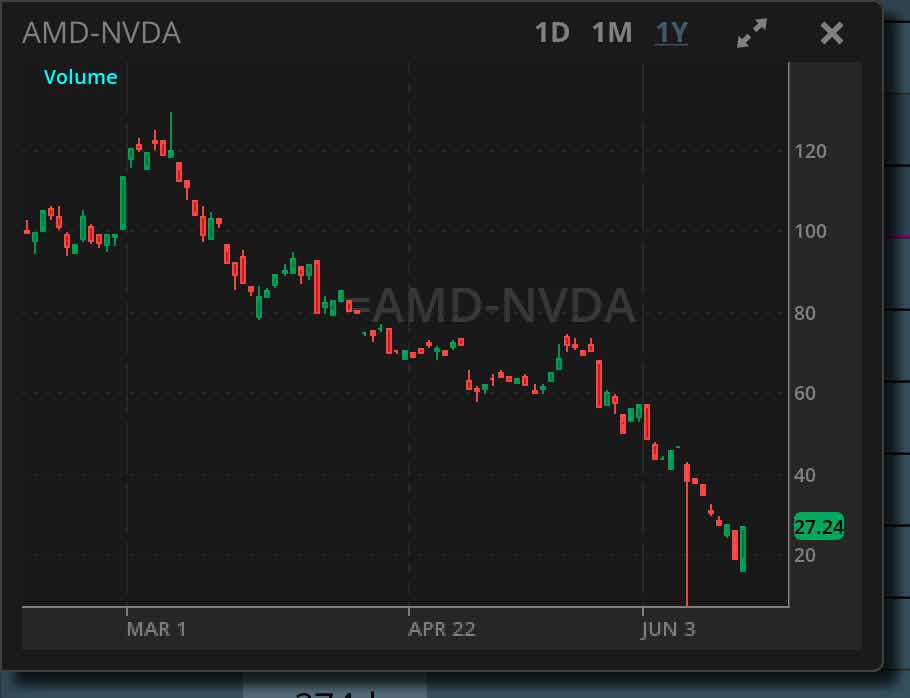But the company has been battling chip-giant Nvidia for market share
-
Advanced Micro Devices (AMD) has been losing market share as Nvidia’s stock price continues to climb.
-
AMD stock surged over $10 (6%) today after news of a data breach was deemed non-material.
-
This is the largest single-day rally in AMD since the initial climb to $220 in late February
-
AMD is set to announce earnings in early August.
AMD stock surges after data breach risk is downgraded
Advanced Micro Devices (AMD) has been a popular rival to the chip-giant Nvidia (NVDA), and both companies have realized massive gains in 2024. AMD stock opened the year at $144.28 and surged to a high of $227.30 on March 8. Since then, the stock has had a tough time catching a bid and has fallen to a low of $141.16. Today, the stock jumped over 6% after recent data breach concerns were brushed to the side, marking the biggest single-day rally in almost four months:

It may be surprising to some to see such a downward movement in the second-largest PC chipmaker, with Nvidia being its largest competitor. Nvidia has had such positive momentum recently that it could be as simple as investors and traders liquidating positions in AMD stock to invest in NVDA stock, especially with the data breach news. And the Nvidia stock split that took place a few days ago makes it more affordable for smaller accounts to buy shares of NVDA stock.
On the tastytrade platform, we can check out the pairs trade feature to view a comparison between AMD and NVDA stock. The image below depicts being long one share of AMD stock, and short one share of NVDA stock to show the strength of the divergence in stock price correlation.

This positive correlation has been in free fall, with Nvidia surging to new highs and Advanced Micro Devices falling from grace. We can turn to implied volatility in the options market to take the pulse of what the market is expecting from AMD moving forward.

The expected stock price move through the first week of August is +-$20.68, based on current implied volatility. This is well over 10% of the current stock price, which shows the market is expecting some realized volatility to come from this upcoming earnings announcement. This is apparent when you look at the December 2024 options cycle expected move of +-$41.32. This is not much more than the near-term expected move we just analyzed, placing a lot of weight on the near-term expected move relative to a cycle much farther out in time.
Bullish on AMD stock in 2024
With AI in the spotlight this year, AMD bulls may believe the recent selloff is over, and the extreme strength we’re seeing today is just the beginning, especially after the negative sentiment around AMD stock was brushed off. AMD is set to announce quarterly earnings in early August, and the stock has only missed earnings-per-share (EPS) and revenue estimates once in the past four quarters. The EPS miss was only by 0.01%.
Bearish on AMD stock in 2024
AMD bears may see this intra-day rally as a relief from negative sentiment. They may also believe that AMD will struggle against the tech-giant Nvidia, and market share may continue to slip into the rival’s hands with a 10x cheaper stock price, where investors can now more easily choose between AMD and NVDA stock. If there is any sort of middling sentiment during the AMD earnings call, or if the company misses on earnings per share (EPS) and/or revenue estimates, we could see the stock fall further.
Tune in to Options Trading Concepts Live at 11 a.m. CDT every market day, as we comb through market movements and analyze earnings previews in depth.
Mike Butler, tastylive director of market intelligence, has been in the markets and trading for a decade. He appears on Options Trading Concepts Live, airing Monday-Friday. @tradermikeyb
For live daily programming, market news and commentary, visit tastylive or the YouTube channels tastylive (for options traders), and tastyliveTrending for stocks, futures, forex & macro.
Trade with a better broker, open a tastytrade account today. tastylive, Inc. and tastytrade, Inc. are separate but affiliated companies.

